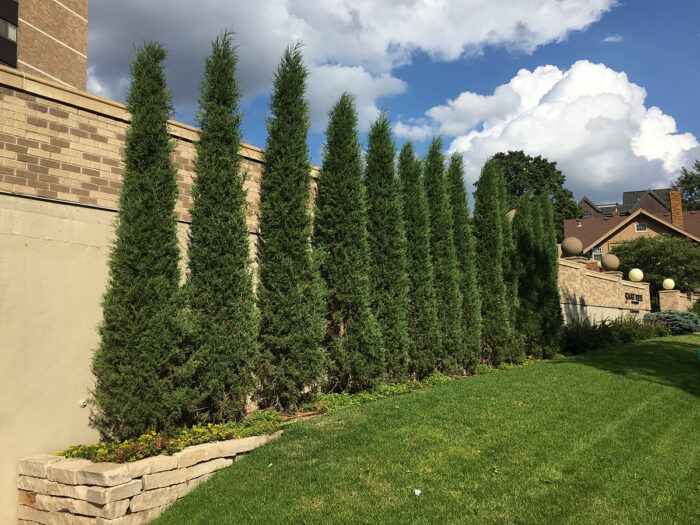
Perhaps you struggle with when it’s appropriate to use an exclamation point at the end of a sentence. However, you don’t need to struggle with when to use one in the garden! If you need a plant for a tall, narrow space in your landscape, or if you need just the right accent, often there is a conifer that can fill the void. In the Southeast, we need to be careful with conifer choices if we want a sure thing. Below are some of the best of the best conifers for narrow, upright forms.
Two striking columnar arborvitaes: One old, one new

One of the first truly narrow selections of arborvitaes to come to market was ‘DeGroot’s Spire’ (Thuja occidentalis ‘DeGroot’s Spire’, Zones 2–7) thanks to plantsman Constant DeGroot of Sheridan Nurseries. It was selected in 1970. Its medium green foliage is somewhat twisted and turns a dark mossy green during the winter. It will reach 15 to 20 feet tall and only 3 to 4 feet wide in 15 to 20 years.

Displaying an eye-popping yellow during spring and summer, ‘Jantar’ arborvitae (T. occidentalis ‘Jantar’, Zones 3–7) was originally found in Poland as a mutation on Emerald Green arborvitae (T. occidentalis ‘Smaragd’, Zones 4–8) and introduced into the United States in 2012. As cold weather approaches, it takes on a warm amber and golden tone. In fact, its name is Polish for amber. Sometimes you will also see this plant sold under the name ‘Amber Gold’. The yellow color of ‘Jantar’ is best in full sun. Expect it to reach 6 to 10 feet tall and 2 to 3 feet wide in 10 years. With a striking upright habit, this selection will add drama to the landscape.
Yew and Japanese plum yew fill the same niche in different zones

‘Viridis’ yew (Taxus × media ‘Viridis’, Zones 4–7) is a slow-growing narrow hybrid between English yew (T. baccata, Zones 5–8) and Japanese yew (T. cuspidata, Zones 4–7). Best suited for cooler regions of the Southeast, ‘Viridis’ is best sited in partial shade, although it can handle more sun with adequate moisture. Ultimate size will be partially dictated by site conditions; however, you can expect mature dimensions of 15 feet tall and 4 feet wide over a very long time. Yews in general take to sheering very well. But nearly every part of this plant is toxic if consumed.

If you live in a hardiness zone where it’s a little too hot for most yews to grow, why not try upright Japanese plum yew (Cephalotaxus harringtonia ‘Fastigiata’, Zones 6–9)? The genus Cephalotaxus is named for its resemblance to yews. The straight species of this plant can get quite large. However, ‘Fastigiata’, which is admittedly rotund for a narrow cultivar, grows 10 feet tall and 5 feet wide over many years. The branches are stiff, with needles spirally arranged around the stems. This plant is traditionally grown in the shade but can handle sun if established with adequate moisture.
Roadside toughness with a formal appearance

There are many unique and narrow forms of Eastern red cedar (Juniperus virginiana, Zones 2–9). However, for overall toughness, tolerance to a variety of conditions, and lack of fussiness, ‘Taylor’ Eastern red cedar (J. virginiana ‘Taylor’, Zones 3–9) is one of the best. ‘Taylor’ is named after the village of Taylor, Nebraska. Allen Wilke, a nurseryman from Columbus, Nebraska, found the plant in 1978. The parent plant was 25 feet tall and 3 feet wide. It was from this tree that Wilke took his original cuttings. You can expect a similar size in your garden. Plants thrive in full sun and are tolerant of almost any soil (except for soggy soils).
Finding the right fit
Be cautious about planting in overly amended, rich soil and using heavy fertilizer for any plant you want to have a narrow form. This can cause a plant you expect to be slender to grow too fast, and its narrowness cannot be guaranteed. Also, when purchasing a plant, look for a specimen with one strong central leader, or remove any branches competing with its central leader. Additionally, pay attention to the expected mature size of narrow plants. Before planting, make sure you have enough space for that plant to reach full maturity. Unless you are planning a yearly pruning regimen or expecting the plant to be temporary, this is very important.
Not all narrow conifers have to be placed on the corner of buildings. Many look their best out in the open, where their tall, narrow forms can be appreciated. Groups of three can be particularly striking where plants are given enough space to be close without touching. If you decide to use these conifers in your garden, have fun, experiment, and enjoy.
—Andy Pulte is a faculty member in the plant sciences department at the University of Tennessee.


















Comments
Log in or create an account to post a comment.
Sign up Log in